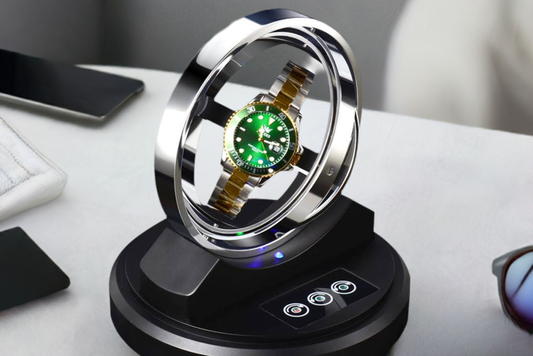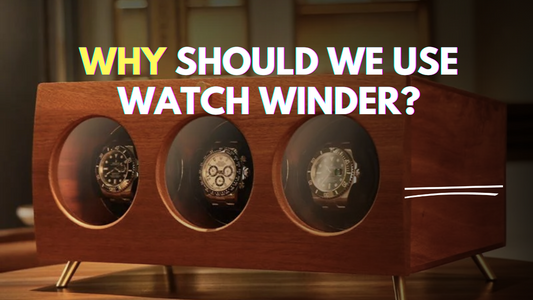Discover the intricacies of automatic and manual watches, unraveling the heart of mechanical timepieces to guide you in making an informed choice for your wrist. Whether you're a horology enthusiast or a first-time buyer, this comprehensive guide delves into the power sources, craftsmanship, precision, design, cost, and lifestyle considerations of these timeless companions.
Credit: YouTube Channel - Tatler Asia
The Heart of the Matter: Power Sources
Automatic Watches: Self-Winding Magic
Automatic watches, also known as self-winding watches, have been a marvel of horology for centuries. These timepieces harness the kinetic energy generated by the wearer's movements, storing it in a mainspring to power the watch's mechanism. The weighted rotor oscillates with the wearer's movements, converting motion into rotational energy, which is then transmitted to the mainspring. This perpetual motion ensures the watch remains accurate and functional without the need for manual winding, offering a convenient and low-maintenance timekeeping experience.
Manual Watches: The Art of Winding
In contrast, manual watches require regular winding to maintain their accuracy. This process involves turning the watch's crown to wind the mainspring, fostering a unique connection between the wearer and the timepiece. The ritual of winding appeals to traditionalists who appreciate the simplicity and durability of manual watches. With fewer components than their automatic counterparts, manual watches are often easier to maintain and repair, making them a reliable choice for those who value longevity.
Complexity & Craftsmanship
Automatics: The Extra Gear
Automatic watches showcase intricate craftsmanship with their additional self-winding mechanisms. The Rolex Submariner, for example, features a complex automatic winding system that allows it to run for up to 48 hours without winding. This added complexity contributes to the watch's sophistication and allure.
Manuals: Pure Mechanics
Manual watches, on the other hand, focus on precise mechanics and accurate timekeeping. The streamlined design of manual watches, like the Omega Speedmaster, emphasizes precision and accuracy. The manual winding process allows the wearer to have more control over the watch's power reserve, ensuring optimal performance.
Precision & Accuracy
Comparing Accuracy
Both automatic and manual watches can be highly accurate, but their accuracy is influenced by different factors. Modern technology has significantly improved the accuracy of automatic watches, with examples like the Rolex Deepsea maintaining precision even in extreme depths. Manual watches, such as the Vacheron Constantin Overseas, rely on consistent and controlled power reserves to achieve higher accuracy.
Longevity of Power Reserve
The power reserve refers to how long a watch can run without winding. Automatic watches generally have longer power reserves due to their self-winding mechanism, with timepieces like the Audemars Piguet Royal Oak boasting a 60-hour power reserve. Manual watches typically require more frequent winding and have shorter power reserves, although exceptions like the Blancpain Villeret offer an impressive 72-hour power reserve.
Design Differences
Case Thickness
Automatic watches tend to have thicker case profiles to accommodate the rotor and its oscillations. The Omega Seamaster Planet Ocean 600M, for instance, has a case thickness of 17.6 mm. In contrast, manual watches like the Vacheron Constantin Patrimony feature slimmer profiles, with a case thickness of 10.4 mm.
Case Weight
The additional components in automatic watches, particularly the rotor, contribute to a heavier overall weight compared to manual watches. The Rolex Submariner weighs around 155 grams, while the manual Patek Philippe Calatrava weighs approximately 72 grams.
Collector's Perspective
Vintage manual watches hold a special appeal for collectors, often featuring intricate craftsmanship, beautiful engravings, and mechanical sophistication. Timepieces like the 1960s Omega Speedmaster and the 1950s Patek Philippe Reference 570 are highly sought after for their historical significance, rarity, and aesthetic appeal. Modern automatic watches, while still valued for their precision and reliability, may not hold the same level of collectibility unless they are limited editions or feature unique complications.
Cost & Frequency
Servicing Needs
Automatic watches typically require servicing every 3-5 years, with costs ranging from $100 to $500 depending on the brand and complexity of repairs. Manual watches need more frequent winding but less frequent servicing, usually every 5-10 years, with costs ranging from $50 to $200.
Repair Simplicity
Manual watches are often considered simpler in design, making them easier to repair and maintain. The fewer components and less complex mechanics result in fewer potential points of failure, reducing the likelihood of costly repairs.
For the Active & Busy
Automatics as a Lifestyle Choice
Automatic watches are the preferred choice for individuals with active and busy lifestyles. The self-winding mechanism eliminates the need for battery replacements and ensures the watch remains accurate even in demanding environments. The Omega Seamaster Planet Ocean 600M and the TAG Heuer Carrera Calibre 5 are popular choices for their robustness and advanced features.
For the Connoisseurs
Manual Watches & Daily Rituals
Manual watches appeal to connoisseurs who appreciate the art of traditional watchmaking and the ritual of winding their timepiece. The deliberate act of winding creates a sense of connection and serves as a reminder of the intricate mechanics and craftsmanship. The Patek Philippe Calatrava and the Vacheron Constantin Patrimony embody the essence of traditional watchmaking with their sleek designs and intricate mechanical movements.
The Final Verdict
Personal Preference vs. Practicality
Choosing between an automatic and manual watch ultimately depends on personal preference, lifestyle, and budget. Automatic watches offer convenience and craftsmanship, while manual watches provide simplicity and precision. Consider factors such as your emotional connection to the timepiece and your daily routine when making your decision.
Future Trends & Collecting
The watch industry is constantly evolving, with trends like the rise of smartwatches and the popularity of vintage watches influencing the market. While some question the relevance of mechanical watches in the face of smartwatches, collectors and enthusiasts argue that the unique experience and craftsmanship of mechanical timepieces cannot be replicated. Vintage manual watches, like the Rolex Submariner, are highly sought after for their rarity and historical importance.
In conclusion, whether you opt for an automatic or manual watch, you are investing in a timeless companion that reflects your personal style and appreciation for horology. By considering the various aspects discussed in this guide, you can make an informed decision and find the perfect timepiece to accompany you on your journey.
Frequently Asked Questions
Are automatic watches always more expensive?
While many high-end automatic watches can be pricey, the cost of a watch depends on various factors such as brand, materials, and features. Both automatic and manual watches can range from affordable to extremely expensive. A basic automatic Seiko can start at around $200, while a high-end Patek Philippe can cost over $100,000. Similarly, manual watches range from affordable options like the Tissot Le Locle at $300 to luxury pieces like the Vacheron Constantin Patrimony at $10,000 or more.
Can manual watches be converted to automatic?
In general, it is not possible to convert a manual watch to an automatic watch due to the fundamental differences in their internal mechanisms. While it might be theoretically possible to modify a manual watch to include an automatic winding mechanism, it would likely require significant and costly alterations. It is often more practical and cost-effective to purchase an automatic watch if that is your preference.
What about the emotional value of winding a watch daily?
For many watch enthusiasts, the act of winding a manual watch daily is an important part of the ownership experience, creating a sense of connection to the watch and the tradition of horology. This ritual allows the wearer to appreciate the craftsmanship and heritage behind the watch. In contrast, automatic watches do not require this daily interaction, which some might see as a loss of intimacy with the timepiece, while others view the convenience as a major advantage.
We hope this comprehensive guide has provided valuable insights into the world of automatic and manual watches. By understanding the differences in power sources, craftsmanship, precision, design, cost, and lifestyle considerations, you can make an informed decision about which type of watch best suits your preferences and needs.
Do you have a preference for automatic or manual watches? Share your thoughts and experiences in the comments below, and feel free to ask any additional questions you may have. Don't forget to share this article with your fellow watch enthusiasts to help them navigate the timeless debate between automatic and manual watches!

![Automatic vs Manual Watches: What Is the Differece? [2024 Guide]](http://uroro.com/cdn/shop/articles/Automatic_vs_Manual_Watches-1717675224.webp?v=1717675242&width=1100)


